BikePortland is covering the Oregon Active Transportation Summit today and tomorrow. We’ve been tweeting updates via #ATSummit and you might have caught our previous post with a recap of the action from the opening speech by Lynn Peterson and a few of the morning sessions.
Between speeches and panel discussions, I try to talk with as many people as possible. The summit serves a wide variety of interests — from agency directors to planners, citizen activists to non-profit staff and volunteers. It’s fun to catch up with such a diverse group and find out about the interesting projects and programs they’re working on. Below are just a few of the folks I ran into…
John Landolfe, transportation options coordinator at Oregon Health & Science University
Landolfe is in charge of making it as easy as possible for students and staff to bike, walk, and take transit to OHSU. His programs serve thousands of people who visit facilities spread between the South Waterfront and “pill hill” — a campus that serves 250,000 annual patients, 5,000 students, and over 16,000 employees. Landolfe’s latest challenge? Serving this community’s needs 24/7. He’s working on OHSU’s first ever “night access plan.” With around 2,000 staffers working the night shift, Landolfe told me he often hears them complain about a lack transit options at night. So he’s partnered with Portland State University to learn more about this issue and figure out how to improve it. To kick things off he plans to launch a survey tomorrow. To stay updated on this effort you can check out the project’s Facebook page.
Susan Kubota, Inna Levin, and Noel Mickelberry; grassroots advocates for walking and safer streets
There’s a lot of talk about Vision Zero these days and these three women are at the front lines of those discussions. Susan Kubota turned the grief over losing her niece Tracey Sparling in a traffic crash into action by becoming a vocal advocate for safer streets. She’s found new life by being involved with a local chapter of Families for Safe Streets, a support and advocacy group for victims of traffic crashes that was founded in New York City. Kubota shared that the founder of our local chapter, Kristi Finney-Dunn, just returned from the Vision Zero Summit where she met with families who started this national movement. Inna Levin is the new volunteer and outreach coordinator for Portland-based nonprofit Oregon Walks. Levin is just the second employee for this scrappy organization. Her focus will include the Sunday Walkways event (set for September 18th) and a series of walks at low-income schools in partnership with the Portland Public School district.
Advertisement
Joseph Marek, Clackamas County traffic engineering supervisor and director of Safe Communities program
I caught up with Marek after his panel on how local governments are implementing Vision Zero. Marek has the bragging rights of being the first county in Oregon to have an official plan to significantly reduce traffic deaths. And they need it: Marek shared there’s currently one death every 13 days and a serious injury every three days in Clackamas County. The County’s 2012 Transportation Safety Action Plan aims for a 50 percent reduction in traffic deaths and serious injuries by 2022 and work toward 365 “fatal free days.” Marek is now starting to work on an update to that plan he expects to have finished by 2017. The “Drive to Zero” campaign focuses on a lot of education in schools and building relationships in every department. “We are putting health and safety into all county policies, so that’s it’s engrained into everything we do,” he said.
Rob Inerfeld, City of Eugene transportation planning manager
Inerfeld was also on the Vision Zero panel. While safety is one of his priorities, right now he’s deep into Eugene’s quest for bike share. Eugene just got back proposals back from would-be operators last week and Inerfeld says they hope to have a system on the ground by next year. So far he’s a fan of the same “smart bike” system Portland will launch in July. All he’s missing so far is a way to pay for it all (that sounds familiar!).
Leah Shahum, Vision Zero Network founder and director
Shahum is dynamic force of nature in the bike advocacy world. We first met her years ago when she was head of the San Francisco Bike Coalition. Now she’s heading up the Vision Zero Network, a coalition group pulling cities together to completely reform how we approach street safety. Shahum has been very busy. Just 26 months ago there were only two U.S. cities that had officially committed to vision zero. Today there are 16. Now that it’s more than buzz-word to policymakers and elected officials, there’s been shift to implementation. “Our job is now to help people really understand what it is. That there’s a difference between vision zero and a traditional safety approach,” she said. “It’s a shift in philosophy.”
Oregon is lucky to have (and host) such an impressive slate of leaders all pushing for better biking, walking, and transit access.
— Jonathan Maus, (503) 706-8804 – jonathan@bikeportland.org
BikePortland can’t survive without subscribers. It’s just $10 per month and you can sign up in a few minutes.

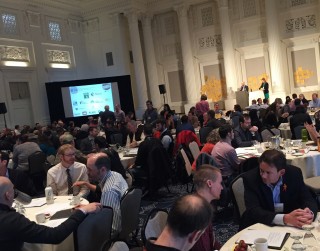
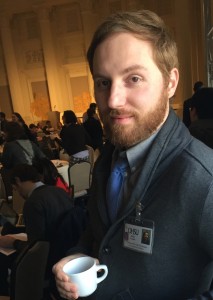
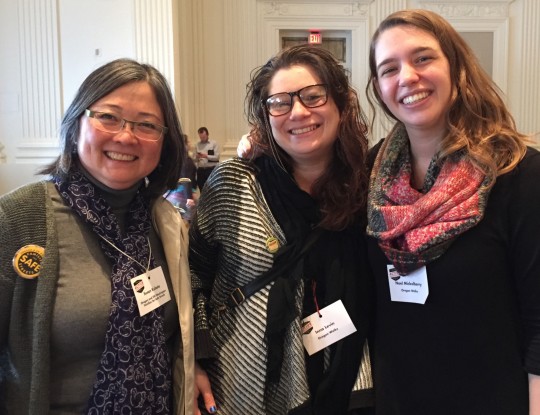
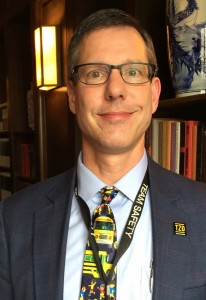

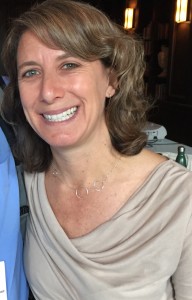
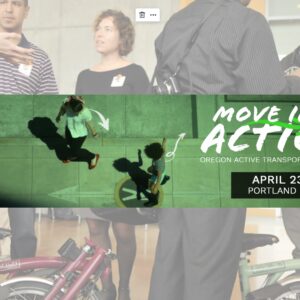
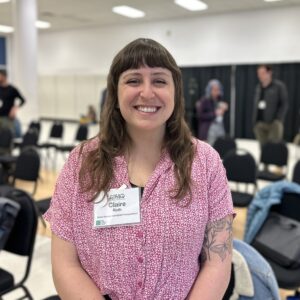
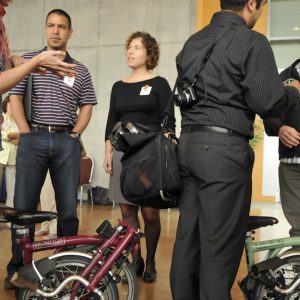

Thanks for reading.
BikePortland has served this community with independent community journalism since 2005. We rely on subscriptions from readers like you to survive. Your financial support is vital in keeping this valuable resource alive and well.
Please subscribe today to strengthen and expand our work.
One question: How many of these people at the active transportation summit that you interviewed came to the event by anything other than personal car?
One criticism: At this point in time, Vision Zero is just a buzz-word. Show me the death reductions and I’ll happily stand corrected. In fact, I’ll jump for joy if we ever get beyond buzz-word status with traffic death reductions.
Remember that PBOT stated they needed 16 months to figure out Vision Zero? I fully expect a robust plan to seriously curtail private car usage and a concrete plan for city-wide protected cycleways, come October. 🙂
And once there’s a plan on the shelves, how long until we reap the fruits? Or will we simply continue to allow the grim one to reap away while we point to our wonderful plan and repeat the sacred manta, “Vision Zero”?
Yes, I’m cynical on this point because to date I haven’t seen any evidence that any jurisdiction is willing to bust out of the status quo. We’ll trim a bit about the edges, but those efforts will have less impact than gasoline price fluctuations.
I get that it’s not politically easy to rein in the scofflaw driving culture. However, I would rather hear elected officials and government staffers acknowledge that we can’t have it all than have them mislead us by pretending that we will do much of anything significant about traffic fatalities without vigorous traffic law enforcement and a host of changes in the penalties for dangerous driving behavior.
there were ~350 attendees and the nice bike valet lot had ~50 bikes.
It’s been a rainy day, though. I think public transit was well utilized. One panelist admitted to using Uber.
Also, a lot of attendees work downtown and prefer to park their bikes in their office or building bike parking garages and then walk over. I for one took transit to my office, then walked over when it started.
It’s important to note that many people come from outside of Portland to attend this. They may not want to figure out where to store their bikes while staying at the hotel so yeah they may have drove from Bend or beyond, but can you blame them?
“One criticism: At this point in time, Vision Zero is just a buzz-word. Show me the death reductions and I’ll happily stand corrected. In fact, I’ll jump for joy if we ever get beyond buzz-word status with traffic death reductions.”
Good news! Total motor vehicle-related fatalities per 100 million vehicle miles traveled has declined from 4.74 in 1970 to 1.07 in 2014.
Total motor vehicle-related deaths declined from 52,627 in 1970 to 32,675 in 2014. (The population of the United States went from 202 million to 318 million over that time period.)
Cars have been getting steadily safer for their occupants over the past 40 years. Not so much for innocent bystanders. Plot the percentage of motor vehicle-related deaths of pedestrians and cyclists over the same period. I suspect those data will tell a somewhat different story.
” I suspect those data will tell a somewhat different story.”
Not true – pedestrian fatalities dropped from 5,801 in 1991 to 4,882 in 2001, to 4,735 in 2013 – not as fast as total motor vehicle fatalities, but still a decline.
Interestingly, the maximum number of pedestrian fatalities in Portland was 52 in 1934 and 1936 (when Portland had about half the population it does today). Ten pedestrians died in Portland in 2013.
I believe you but I would like to see more data on this. Are there fewer miles walked per capita than in 1991?
VMT based metrics are commonly used, but may not be the best metric. The OECD reports national crash rates using million vmt and 100k population. Is a city with 50 fatalities per year, 500,000 population, and 15 million annual vmt safer than a similar size city with 30 million annual vmt and 50 fatal crashes per year? The fatal crashes per 100k population is the same, 10, while the fatal crashes per million vmt in the second is half that of the first.
Car centric pov is part of the issue.
In addition to his role with Clackamas County, Joe Marek is also president of the Oregon City Trail Alliance and probably does more to promote active transportation in Clackamas County than anyone else here.
As a member of Oregon City’s Transportation Advisory Committee I have had multiple occaisions to here him and his staff present and Joe is the real thing. He truly means to do everything he can to see traffic fatalities in our county go away.
I’m going to guess that most of us here can’t keep up with him on a bike either.
Yep to this, Joe is the real deal.
I see several women, but lest anyone think that Vision Zero is just another Patronizing White People idea, maybe find some more people of color?
I think there are a lot of people who care less about the number than the operator. It’s hard to believe in Zero when you can’t get equality.
This whole “everything is about race/gender” is getting tired.
Forest through the trees, people!
Unfortunately, the topic of equality needs to be constantly brought up for consideration, at least until it is no longer applicable.
While I can’t speak for Champs, it’s really not fun to have to call this shit out each and every time.
It’s not just about head counts, because the results of well-meaning advocates can have unintended consequences – mostly around misunderstandings and omissions.
On a related note:
I used to attend this event regularly, but now I’m priced out. This, and BTA’s Alice, are no longer doable for me. Why have sliding scales been largely phased out? I can’t imagine they were abused that much. ‘Sliding Scale’ is a policy of inclusion.
https://www.portlandoregon.gov/transportation/article/555904.
Equality and equity are very much part of the discussion and goals of the Vision Zero Task Force.
That may be true for white folks, but for many people of color almost everything IS about race and it is inescapable.
And if the suggestion is that Vision Zero is something where race does not matter, I suggest reading this recent post: http://bikeportland.org/2016/02/25/five-ways-vision-zero-must-should-address-race-and-income-176070
And in that forest, I bet you see a lot of trees that look like you. If you don’t see this monoculture as a problem, then the definition of “patronizing” is well worth looking up.
“The latest trendy policy without your input will benefit you, and this time we really mean it!”
Good on them for holding the summit.
Does anyone know how many years this has been held?
Since at least 2010, not sure before that.
I’ll also vouche for Joe. I worked at and bike commuted to clackamas county for for five years. Joe was a consistent bike commutter. He put on a “how to be a bike commuter” seminar at clackamas county in effort to get more of us. If you race cross at Barton, Joe is a big reason that race happens. I know he doesn’t race like he used to but he was an avid cross and mountain bike racer for team S&M. He’s finished more than one cascade cream puff and was racing the mudslinger from its inception. In fact he had a couple of commuter bikes that were former race bikes of Barry Wicks. Joe is exactly who you want in transportation in clackamas county and a all around good guy.
It’s so great to have a shoutout for the OHSU Night Access Plan! I’m excited to be working on the project. One note: there is probably more relevant information on our website: http://www.hilltopplanning.com/
Diverse? This is a diverse group of almost entirely white people who all share a viewpoint about transportation that is clearly not mainstream. Not to hold any of the attendees accountable—people are who they are—but I’m concerned of the echo chamber effect. I’d love to hear voices of the people the activists claim to represent, and—although I say this with trepidation—I’d be interested in hearing from people who haven’t got the religion regarding active transportation, so that we can figure out how to bridge the gap.
It is my belief that we won’t change the world—or anything, for that matter—by asking people to act daily out of altruism. The thing that is best for society must also be the best for all individuals as well. Active transport must be the quickest, easiest, and most affordable option in reality and perception for the mass of people to adopt it. I hope this summit deals with that issue.
Yes. Diverse. Here’s the definition of that word: “showing a great deal of variety; very different.”
Keep in mind it’s possible that word means different things in different contexts and to different people. In this case, I was referring not to the people themselves but to their professional perspective… as in citizen activists, professional advocates, county employee, and so on.
Fair point. We do have to be mindful of what people end up having the biggest voice in this discussion. I’m really happy to see so many women, though.
According to the census 85-88% of Oregon residents are white. Hispanic is the next largest group. All other minorities are less than 2% of the state population. It would be nice if we were a more diverse state but the statistics say we are pretty darn white.
From above, the image captioned: “[a]bout 300 people at the summit this year.”
Based on that sample can you imagine anywhere close to 40+ people of color in that crowd, or does it look like an equestrian club dinner reception?
Fixating on one aspect of identity (skin color) to the marginalization of others is just as plainly misguided as focusing on someone’s height or age.
The representation of diversity will never be equal in all areas of expertise due to factors far more complex than skin color. While we can do things to ENCOURAGE all people to feel welcome, mandating color quotas at a professional active transportation summit would be highly counterproductive.
Think bigger.